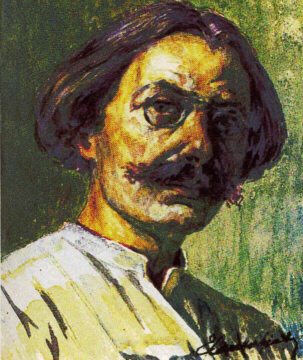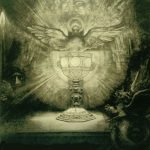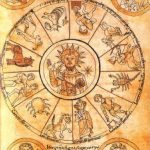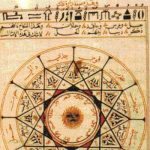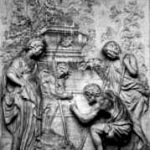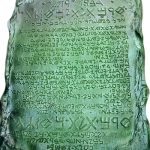Chapter Twelve
And so, at long last, we arrive at the point where Fulcanelli began, the Gothic Cathedrals of Europe. In his 1926 masterpiece, The Mystery of the Cathedrals, Fulcanelli claimed that the Gothic Cathedrals were Hermetic libraries in stone with the secret of alchemy displayed for all who could to read it. When our investigation began, this seemed, in its own way, the most incredible of all Fulcannelli’s claims. It was easier to believe that someone had stumbled privately onto the real secret behind the alchemical transformation, than it was to believe that some secret society, or societies, had encoded this information deliberately into the design and the decorations of the greatest of all Christian monuments.
For this to be true, several important preconditions would also have to be true, such as the existence of a secret, or not so secret, group with access to the highest levels of the church, bottomless wealth, connections with the Holy Land and the Moslem world, and knowledge of the inner core of alchemy. Before we, as researchers, could take Fulcanelli’s claims seriously, we needed to validate the existence of such a group. The importance of this point is obvious. If Fulcanelli were merely projecting from his own unconscious the meanings he gives certain images and motifs found in the cathedrals, rather than revealing an ancient alchemical tradition, then Mystery of the Cathedrals is reduced to a work of symbolist fantasy. Interesting, and useful to the psychologist perhaps, but of limited value in terms of alchemy.
Yet this is, if anything, Fulcanelli’s main point. Mystery is not the usual alchemical cookbook or grimoire. Fulcanelli implies that he is revealing the mystery of alchemy as it was taught to him, by reference to the Hermetic meanings embodied within the cathedrals. It is therefore a demonstration not just of the alchemical philosophy, but of how this philosophy animated a lost medieval golden age. The key to understanding Fulcanelli’s importance, and not just the value of his work, lies in the reality of this lost knowledge and the fact of its emergence as symbols on the walls of these imposing Christian structures.
We began our search with the origin of alchemy and discovered that alchemy, while referencing back to the knowledge of a pre-catastrophe civilization, appeared in its modern form as part of the Gnostic ferment of the 1st century CE. This Gnostic world view, derived from the mystery cults of the rapidly collapsing ancient world, supplied a theological and mythological framework for the emerging wave of monotheistic mysticism, such as Christianity and Essene Judaism. This framework also contained the essential ideas of alchemy’s triple transformation. The specific magickal technology of the triple transformation — inner yogic psycho-sexual disciplines, magickal ceremonies combined with manipulation of sacred metals, and the secret of time and timing, including the beginning and end of time — developed first within the Gnostic cults, including Christianity, and then dispersed into the intellectual underground of the Dark Ages.
As part of the Gnostic paradigm, alchemy was influenced by Gnostic eschatological teachings, such as the path of return by the small lights to the One Light. Two thirds of the transmutational secret was persecuted out of Orthodox and Imperial Christianity, while the remaining third of the secret, that of time itself, was co-opted by its temporal leaders, such Constantine, Charlemagne and Otto I. For the Christians, the whole idea of the end of time became confused with the fall of the Roman State, and the apocalypse against heretics became an institution of the church. But the idea of a transformed reality, the Chilaist vision of a new heaven and a new earth purged of sin, refused to die out.
This concept of a spiritually animated matter became the keystone of the alchemical process. The illuminated Hebrew mystics of the Bahir recorded the techniques of animating matter and related them directly to the transformational process of galactic alignment. The Shi’ites, Fatimids and Ismailis alike, believed that Mohammed had received this information and passed on the secret of time, and the coming of the Day of Judgment, through the family of Ali. The Sufis, of all persuasions, retained the most complete understanding of the internal psycho-sexual transformation.
We found that by the 10th century, alchemical knowledge had fragmented to the point that the secret had effectively been lost. The Byzantine Greek compilations of that era are composed of older material, much of it from the 1st century, such as the “Isis the Prophetess” story. The Islamic current had likewise split into the compilers and philosophers versus the mystical and the political. Among the Jews of the Dispersion, knowledge of the Bahir was limited to several small family groups in Spain and Palestine. The information was on the verge of being lost, and it was hard to see how in a few short centuries it could have been revived and then become influential enough to appear on the cathedral walls.
Working backward from the cathedrals themselves, we found that there were indeed enough mysteries to drive a small army of secret societies through. “Why did western Europe build so many churches in the three hundred years after the year 1000? What need was there, in a Europe with hardly a fifth of its present population, for temples so vast that they are now rarely filled even on the holiest days? How could an agricultural civilization afford to build such costly edifices, which a wealthy industrialism can barely maintain?” These questions were asked by no less an authority than Will Durant in his chapter, in volume IV of the History of Civilization, on the development of the Gothic cathedrals.
And who designed them? Who decided on the artwork, laid out the ground plan, supervised the construction and the decoration? These are mostly unanswered, and now unanswerable, questions. We know the names of these “master masons,” but their history and the story of their work has for the most part been lost. But the fact of that work, its skill and symbolic integrity, points to the sophisticated degree of organization, perhaps even on an international level, required to produce such elaborate and long term projects. Buildings of such complexity and elegance do not happen by accident.
As Durant noted, the year 1000 was a significant one to western Christendom. As we began to investigate this significance, we came face to face with one of the seminal figures in the transition from the Dark Ages to the medieval world, Pope Sylvester II. As we saw in a previous chapter, The Hermetic Pope proved to be the lynch-pin in a complex series of events that resulted in effects as wide ranging as the Crusades, the Templars, the Peace of God movement and its heretical offshoots, the Grail Romances and eventually, the cathedral building movement itself.
As we followed the tangled pattern of Sylvester’s career, we found the seeds of our sophisticated international organization in the various chronicling orders established by Sylvester within, and on the edges of, the other monastic orders, the Benedictines, the Cluniacs and the Cistercians. This fluidity of organization gained a central focus with the establishment of the group of chroniclers at Jerusalem in 1002. From that point on we can safely speak of an Order of Sion, in Jerusalem, with connections among all three major monastic orders back in Europe.
During the 11th century, all of these monastic orders began to build in the pre-Gothic style known as Romanesque. Within these monastic communities, groups of specialists developed. These were monks and scholars who knew Greek and mathematics, especially geometry, and were also skilled in building. As these “schools” grew, they were influenced by architecture from many distant places, the Hagia Sophia in Constantinople, the Al-Aqsa Mosque, The Dome of the Rock, in Jerusalem, and the Mosque of ibn Tulun in Cairo. It is not hard to see the Order of Sion, with its Byzantine and Fatimid connections, as the source of that influence.
After the First Crusade conquered Jerusalem, The Order of Sion became, in various ways, the “rock” upon which the Kingdom of Jerusalem was founded. The Order used its connections back in Europe to capitalize on the discovery, around the 1102, of the alchemical and cosmological secrets. A decade later, wealth began flowing back to Europe, mostly to the Cistercians, a formerly bankrupt splinter group of Cluniac monks led by the future St. Bernard. By 1130, the Templars had been established, St. Bernard was the foremost Christian of his day, and Europe was poised on the edge of the cathedral building mania. Gothic is in the air, but has yet to be given form. For that we have to thank St. Denis and the Abbot Suger.
* * * * *
A few miles north of the Ile de Citie, The Abbey of St. Denis, patron saint of Paris and by extension France itself and its Capetian kings, grew up around the tomb of the saint and his venerable relics. St. Denis had been recognized by the heirs of Charlemagne and a small Carolingian church was built on the site in the mid-9th century. The abbey itself was founded by Hugh Capet and our old friend Gerbert of Aurillac, Archbishop of Rheims, in the early 990’s, and become over time the family chapel of the French dynasty. As St. Remy and Rheims became associated with the founding of the first Merovingian dynasty, St. Denis became associated with its Capetian revival.
The future Abbot Suger was born in poverty in the village of St. Denis. His innate intelligence won him a place in the local monastery school, the Prieure de l’Estree, where he became friends with the future King of France, Louis VI. Suger was noticed by the royal family. Phillip I encouraged the friendship between his son and the brilliant scholar. In the early 1120’s, Suger was sent to Rome several times on diplomatic missions. During his time at the Holy Curia in the early 12th century, Suger came into contact with all the major intellectual currents of his age, including perhaps the secret discoveries in the Holy Land.
During the second decade of the 12th century, Suger served as prime minister of France and was at the center of the struggle between the French state and the church. Suger naturally sided with his old school chum, Louis VI, and his son, Louis VII, against the anti-Popes of the Holy Roman Empire. He was a man who spent most of his life dealing with the intricacies of medieval power politics, and when he talked, the King of France listened.
In 1123, at the height of his power and influence, Suger became the Abbot of St. Denis. Perhaps because of his knowledge of the discoveries in Jerusalem and their apparently inexhaustible wealth, Suger pressed for the re-building of the old Carolingian church into something that would be the wonder of Europe and the proper venue in which to display the relics of St. Denis and the regalia of the Capetian Kings. Abbot Suger envisioned his church as the center of the new illuminated Christianity that seemed to be overtaking the old politically compromised Roman church in the early years of the 12th century.
That St. Denis, rather than say Rheims with its much more prominent Merovingian connections, was singled out as the source point for the Gothic transformation depends as much on a mis-identification as it does on Abbot Suger energy and political savy. Not much was known of the historical saint. The abbey library contained a volume of works attributed to him, but which were actually written by the 2nd century Gnostic philosopher Dionysius the Areopagite. The book, given to one of Charlemagne’s sons by the Byzantine Emperor Michael the Stammerer, ended up in the abbey’s library perhaps as the result of Pope Sylvester’s chroniclers.
Abbot Suger was greatly influenced by Dionysius’ Gnostic theology of light. Dionysius believed that “every creature, visible or invisible, is a light brought into being by the Father of Lights,” and celebrated the Divine Light, God’s holy fire, which animated the entire universe. This is amazingly similar to the basic Gnostic concept of the path of return. Abbot Suger took this theme to heart. In his three books on the building and consecration of the church, we find no less than thirteen separate inscriptions celebrating the holy Light. In one of them, a verse written to celebrate a gilded bronze gate, Suger tells us: “Bright is the noble work, this work shining nobly/ Enlightens the mind so that it may travel through the true lights/ To the True Light where Christ is the true door.”
From these ideas, Abbot Suger developed his theory of lux continua, or continuous light. With these two words, Suger announced the birth of the Gothic style and at the same time pointed to its spiritual roots in the Gnostic illuminism of alchemy. From this point on, the walls of sanctity would be shattered to let the light in. The solemn and suffering darkness of the Romanesque would be replaced by the flow of continuous radiance at the heart of the Gothic.
By 1133, Abbot Suger informs us, he had collected artists and craftsmen “from all lands,” including a contingent of Arabic glass makers. Suger did not invent stained glass; as we saw above, the Fatimids had used it in their mosques for over a century. Glass making seems to have been a component of the alchemical process. We find it mentioned in the preparations of certain “sands” described in the “Isis the Prophetess” text. The Fatimid scholars and mystics of Cairo used colored glass fashioned in geometrical patterns as a meditation tool, as seen in the remaining stained glass of the Al-Azhar mosque. The good Abbot’s idea was to use the stained glass to fill the interior of his church with sparkling jewel-like color.
Bright indeed is the noble work. Abbot Suger approached the building of his new church with all the enthusiasm, and attention to detail, of the Renaissance alchemist in pursuit of the Philosopher’s Stone. To Abbot Suger, perhaps, his new light filled church was the true Philosopher’s Stone.
It was finished in 1144, and the dedication was attended by a veritable who’s who of the mid-12th century. Louis VII attended with his soon to be divorced wife, Eleanor of Aquitaine, as did most of the bishops of the western church and hundreds of knighted nobles. Even St. Bernard, who was heard to grumble at the expense of gilding a church, attended, compelled perhaps by an authority greater than his own ego, the power brokers of Sion.
From its beginnings at St. Denis, the new style spread first through central France, and then all over Europe, from England to Germany, Portugal to Northern Italy. The collection of artists and craftsmen assembled by Abbot Suger developed into schools and guilds that traveled throughout Europe for the next two centuries or so creating a vast collection of Gothic churches and civic buildings. Twelve years after the good Abbot’s death in 1151, his student, the Bishop of Paris, Maurice de Sully, and his “master mason,” William of Paris, paid him the compliment of bettering his design.
On an island in the Seine, the new cathedral of Notre Dame de Paris rose slowly into the light filled sky. Work on the choir and transepts were begun in 1163 and not completed until 1182. By the time the construction of the nave was under way, another change was sweeping through Christendom.
Jerusalem and most of Holy Land was conquered in 1187 by the forces of the Seljuk Sultan Saladin. The west was stunned and plans began for an immediate Crusade, the Third according to modern historians. (The Second Crusade had been the unhappy affair undertaken in 1147 by Louis VII, during which the Abbot Suger of St. Denis ruled France as regent. Suger in fact did do so well with the realm’s finances that Louis’ disastrous crusade hardly made a dent in the royal coffers.) In the midst of this political upheaval occurred the Cutting of the Elm at Gisors, the schism between the Order of Our Lady of Sion and the Knights of the Temple of Solomon. For over a decade, Sion had been building a private power base back in Europe, and after the loss of the abbey on Mount Sion, the entire Order relocated.
This shift began in 1152, the year after Abbot Suger’s death, with Louis VII’s gift to the Order of the large priory at Orleans of St. Samson, another Dark Age saint with Merovingian connections. By 1178, as we noted above, the Order was confirmed by the Pope in the possession of houses and large tracts of land from the Holy Land to Spain. The Cutting of the Elm at Gisors did more than just split the Templars off from its parent Order, it defined the boundary line between the Plantagenets on one side, supported by the Templars, and the Capetians on the other, supported by Sion. This division would eventually produce not just the destruction of the Templars by the French King, Philip III and his puppet Pope, Clement V, but the catastrophe of the Hundred Years War between France and England.
As the walls of Notre Dame de Paris rose, the foundations of the new illuminated Christendom began to crumble. Loss of Jerusalem, and eventually the rest of Outremer, made the universal nature of the church questionable. The Grail Romances, whose imagery would appear in the decorations of both Notre Dame de Paris and the cathedral at Amiens, attempted an end-run around the church itself by appealing directly to a chivalric sense of destiny. With the failure of the Third Crusade and the subsequent strife among its leaders, the grand plan began to falter.
The Orthodox church fought back in the so-called crusades against Christians. First, almost by accident, Constantinople was conquered by the Fourth Crusade. This empowered Pope Innocent III to go after the heretics in southern France. Fifty years later, with southern France and its culture destroyed, the hope of a new kind of Christianity, once so promising, had been lost.
* * * * *
For a century after the discoveries in the Holy Land, alchemy remained the secret preserve of the initiates within the church. The Order of Sion and the Templars seem to have had their own alchemical processes and their own individual codes for referring to it. Not until the middle of the 13th century did alchemy surface in a direct and unambiguous way.
By the time the external decorations, including the magnificent bas-relief rendition of Alchemy itself on the Great Porch of Notre Dame de Paris, were finished in 1235 the reason for secrecy had passed. The Imperial Orthodox Church of Rome was in ascendancy with both the Templars and the Order of Sion struggling to find a new mission. Power politics had also stabilized, somewhat, with the Holy Roman Empire as top dog of the feudal pack. The Middle Ages were reaching for their apogee, while falling, at the same time, far short of the glorious millenarial visions of Sylvester II and the pilgrim/warriors of the First Crusade.
The greatest scholar of the 12th century, Albert the Great of Cologne, or Albertus Magnus, turned to alchemy in the mid century, and produced the first original work on the subject since the late fifth century. His treatise, On Alchemy, champions alchemy as a difficult but true art. He does not tell us if he actually made gold, but his directions to the practitioner indicates not only a knowledge of the triple nature of alchemy, but an awareness of the changes in the political winds. He warns the alchemist to chose the right hour for his operations, be patience and diligent in his prayers and exhortations, operate by the rules (here Albert gives us the necessary steps: trituration, sublimation, fixation, calcination, solution, distillation and coagulation, seven in all), and to always avoid contact with princes and rulers.
Albert was also reputed to have had a fortune-telling “head” and seems by contemporary accounts to have been an adept of the Hebraic work of creation. We are told that he had constructed an artificial man, a Golem, endowed with the ability to speak but not to reason. The golem’s inane chattering so disturbed Albert’s pupil, the future saint, Thomas of Aquinas, that Albert finally had to destroy it. Another interesting alchemical story, related by William II, Count of Holland, has Albert setting a feast in the frozen and snow covered garden of the monastery, only to have it magically become summer, with birds, butterflies and blossoming trees, as the diners sat down to their meal.
Intriguing as these suggestions are, it was not the aristocratic Albert the Great who brought alchemy firmly into the mainstream of medieval thought, but the humble scholar Arnold of Villanova. Arnold was born in Valencia about the time that Notre Dame de Paris was finished. He gained his initial fame as a physician, and could be called the first psychologist, having written a surprisingly modern work on the interpretation of dreams. Although seemingly not a member of any monastic or clerical order, Arnold conducted secret missions for kings, Emperors and Popes alike.
In his works, Arnold emphasized the reality of alchemical transformation. To demonstrate this, he performed a transmutation in front of Pope Boniface VIII. It was successful, the first documented account of such a transmutation. A witness, John Andre, the Major Domo of the Papal Curia, reports that Arnold “submitted the gold sticks he produced to everyone for examination.” This is very significant for the simple reason that since the second century, no one, no matter how much they seemed to know about alchemy, had actually done the transmutation in front of witnesses. Arnold’s performance in front of Boniface was the turning point in alchemical history. Unfortunately, it was also the beginning of the end for the Templars, and in a lesser way, for the Order of Sion.
One of those observing Arnold’s transmutation was the future Pope Clement V. Bertrand de Got, the former Archbishop of Bordeaux, became the first Pope of the so-called French captivity after the strife caused by Boniface VIII’s assertion of absolute Papal rights. The King of France, asserting a higher spiritual and political authority than the Pope swooped down on Rome and literally captured the church. Eleven months later, Bertrand, a Frenchman, was finally elected as Clement V. Arnold, unfortunately, had been in the thick of the political in-fighting.
Phillip, the French King, used his power over the Pope to recall Boniface’s proclamation. And then the King set in motion an idea that had stirring in his brain since Arnold’s demonstration. The King called a General Council and proscribed the Templars. Pope Clement V, wanting his piece of the vast Templar wealth, went along with Phillip, even though he knew the charges against the Templars were basically groundless.
More Articles from Sangraal.com:
Submit your review | |

